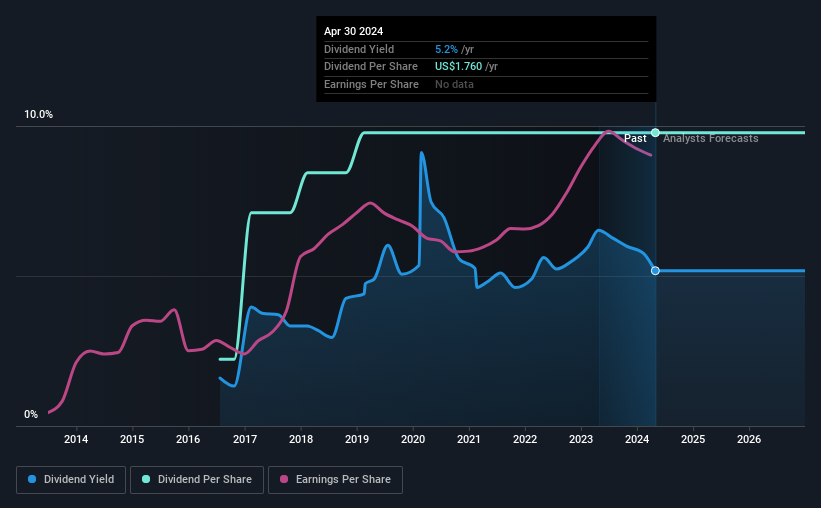The Bank of N.T. Butterfield & Son Limited (NYSE:NTB) Looks Interesting, And It's About To Pay A Dividend
The Bank of N.T. Butterfield & Son Limited (NYSE:NTB) stock is about to trade ex-dividend in four days. The ex-dividend date is usually set to be one business day before the record date which is the cut-off date on which you must be present on the company's books as a shareholder in order to receive the dividend. The ex-dividend date is important as the process of settlement involves two full business days. So if you miss that date, you would not show up on the company's books on the record date. This means that investors who purchase Bank of N.T. Butterfield & Son's shares on or after the 6th of May will not receive the dividend, which will be paid on the 21st of May.
The company's next dividend payment will be US$0.44 per share. Last year, in total, the company distributed US$1.76 to shareholders. Based on the last year's worth of payments, Bank of N.T. Butterfield & Son has a trailing yield of 5.2% on the current stock price of US$34.00. Dividends are a major contributor to investment returns for long term holders, but only if the dividend continues to be paid. So we need to investigate whether Bank of N.T. Butterfield & Son can afford its dividend, and if the dividend could grow.
View our latest analysis for Bank of N.T. Butterfield & Son
Dividends are typically paid from company earnings. If a company pays more in dividends than it earned in profit, then the dividend could be unsustainable. That's why it's good to see Bank of N.T. Butterfield & Son paying out a modest 39% of its earnings.
When a company paid out less in dividends than it earned in profit, this generally suggests its dividend is affordable. The lower the % of its profit that it pays out, the greater the margin of safety for the dividend if the business enters a downturn.
Click here to see the company's payout ratio, plus analyst estimates of its future dividends.
Have Earnings And Dividends Been Growing?
Stocks in companies that generate sustainable earnings growth often make the best dividend prospects, as it is easier to lift the dividend when earnings are rising. If earnings fall far enough, the company could be forced to cut its dividend. With that in mind, we're encouraged by the steady growth at Bank of N.T. Butterfield & Son, with earnings per share up 5.7% on average over the last five years.
Another key way to measure a company's dividend prospects is by measuring its historical rate of dividend growth. Bank of N.T. Butterfield & Son has delivered 20% dividend growth per year on average over the past eight years. It's encouraging to see the company lifting dividends while earnings are growing, suggesting at least some corporate interest in rewarding shareholders.
To Sum It Up
Is Bank of N.T. Butterfield & Son worth buying for its dividend? Bank of N.T. Butterfield & Son has seen its earnings per share grow slowly in recent years, and the company reinvests more than half of its profits in the business, which generally bodes well for its future prospects. Overall, Bank of N.T. Butterfield & Son looks like a promising dividend stock in this analysis, and we think it would be worth investigating further.
So while Bank of N.T. Butterfield & Son looks good from a dividend perspective, it's always worthwhile being up to date with the risks involved in this stock. For instance, we've identified 2 warning signs for Bank of N.T. Butterfield & Son (1 makes us a bit uncomfortable) you should be aware of.
A common investing mistake is buying the first interesting stock you see. Here you can find a full list of high-yield dividend stocks.
Have feedback on this article? Concerned about the content? Get in touch with us directly. Alternatively, email editorial-team (at) simplywallst.com.
This article by Simply Wall St is general in nature. We provide commentary based on historical data and analyst forecasts only using an unbiased methodology and our articles are not intended to be financial advice. It does not constitute a recommendation to buy or sell any stock, and does not take account of your objectives, or your financial situation. We aim to bring you long-term focused analysis driven by fundamental data. Note that our analysis may not factor in the latest price-sensitive company announcements or qualitative material. Simply Wall St has no position in any stocks mentioned.

 Yahoo Finance
Yahoo Finance 
